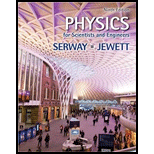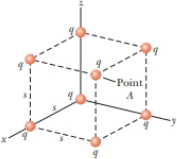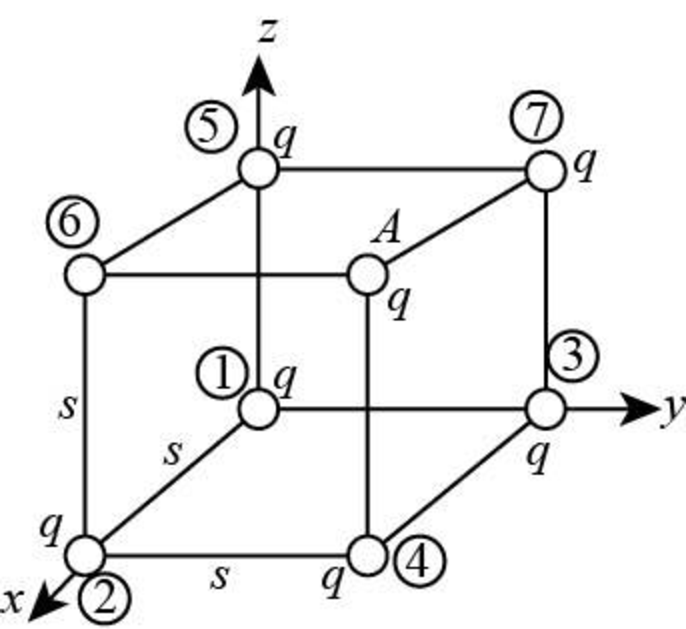
Concept explainers
Eight charged panicles, each of magnitude q, are located on the corners of a cube of edge s as shown in Figure P22.48. (a) Determine the x, y, and z components of the total force exerted by the other charges on the charge located at point A. What are (b) the magnitude and (c) the direction of this total force?
Figure P22.48

(a)
The
Answer to Problem 23.85CP
The
Explanation of Solution
The side of the each cube is
Write the expression for the coulomb’s force law between the two charges
Here,
The charge configuration is as shown in figure below.

Figure (1)
The charges present at the sides are distance
For the net force in
For force due to charge 6 is only in the y-direction
Substitute
The force due to charge 5 and 2 makes an angle
Substitute
Substitute
The charge 1 is
Write the expression for the cosine value of the angle
Write the expression for the force due to charge 1
Substitute
Substitute
Write the expression for the net force in
Substitute
Thus, net force in
From the cubical symmetry the net force in
Thus, net force in
And the net force in
Conclusion:
Therefore, the
(b)
The magnitude of the net force.
Answer to Problem 23.85CP
The magnitude of the net force is
Explanation of Solution
The side of the each cube is
Write the expression for the magnitude of the net force
Substitute
Conclusion:
Therefore, the magnitude of the net force is
(c)
The direction of the net force.
Answer to Problem 23.85CP
The direction of the net force is away from the origin.
Explanation of Solution
There is a force component in
Hence, the net force isn’t along any particular direction rather it has components in all three directions with equal magnitudes and it is pointed away from the origin
Conclusion:
Therefore, the net direction is away from the origin making equal angle with all the three axes.
Want to see more full solutions like this?
Chapter 23 Solutions
PHYSICS 1250 PACKAGE >CI<
- pls help asaparrow_forwardpls help asaparrow_forward2. Max is swimming across a river that is 42.6 m wide. He can swim at 1.6 m/s and heads 20° to the right of the vertical. There is a current pushing him more to the right and it has a speed of 0.30 m/s. Determine the time it takes him to cross the river and find out how far downstream he ends up. Draw the diagram.arrow_forward
 Physics for Scientists and Engineers: Foundations...PhysicsISBN:9781133939146Author:Katz, Debora M.Publisher:Cengage Learning
Physics for Scientists and Engineers: Foundations...PhysicsISBN:9781133939146Author:Katz, Debora M.Publisher:Cengage Learning Physics for Scientists and EngineersPhysicsISBN:9781337553278Author:Raymond A. Serway, John W. JewettPublisher:Cengage Learning
Physics for Scientists and EngineersPhysicsISBN:9781337553278Author:Raymond A. Serway, John W. JewettPublisher:Cengage Learning Physics for Scientists and Engineers with Modern ...PhysicsISBN:9781337553292Author:Raymond A. Serway, John W. JewettPublisher:Cengage Learning
Physics for Scientists and Engineers with Modern ...PhysicsISBN:9781337553292Author:Raymond A. Serway, John W. JewettPublisher:Cengage Learning Principles of Physics: A Calculus-Based TextPhysicsISBN:9781133104261Author:Raymond A. Serway, John W. JewettPublisher:Cengage Learning
Principles of Physics: A Calculus-Based TextPhysicsISBN:9781133104261Author:Raymond A. Serway, John W. JewettPublisher:Cengage Learning College PhysicsPhysicsISBN:9781305952300Author:Raymond A. Serway, Chris VuillePublisher:Cengage Learning
College PhysicsPhysicsISBN:9781305952300Author:Raymond A. Serway, Chris VuillePublisher:Cengage Learning College PhysicsPhysicsISBN:9781285737027Author:Raymond A. Serway, Chris VuillePublisher:Cengage Learning
College PhysicsPhysicsISBN:9781285737027Author:Raymond A. Serway, Chris VuillePublisher:Cengage Learning





